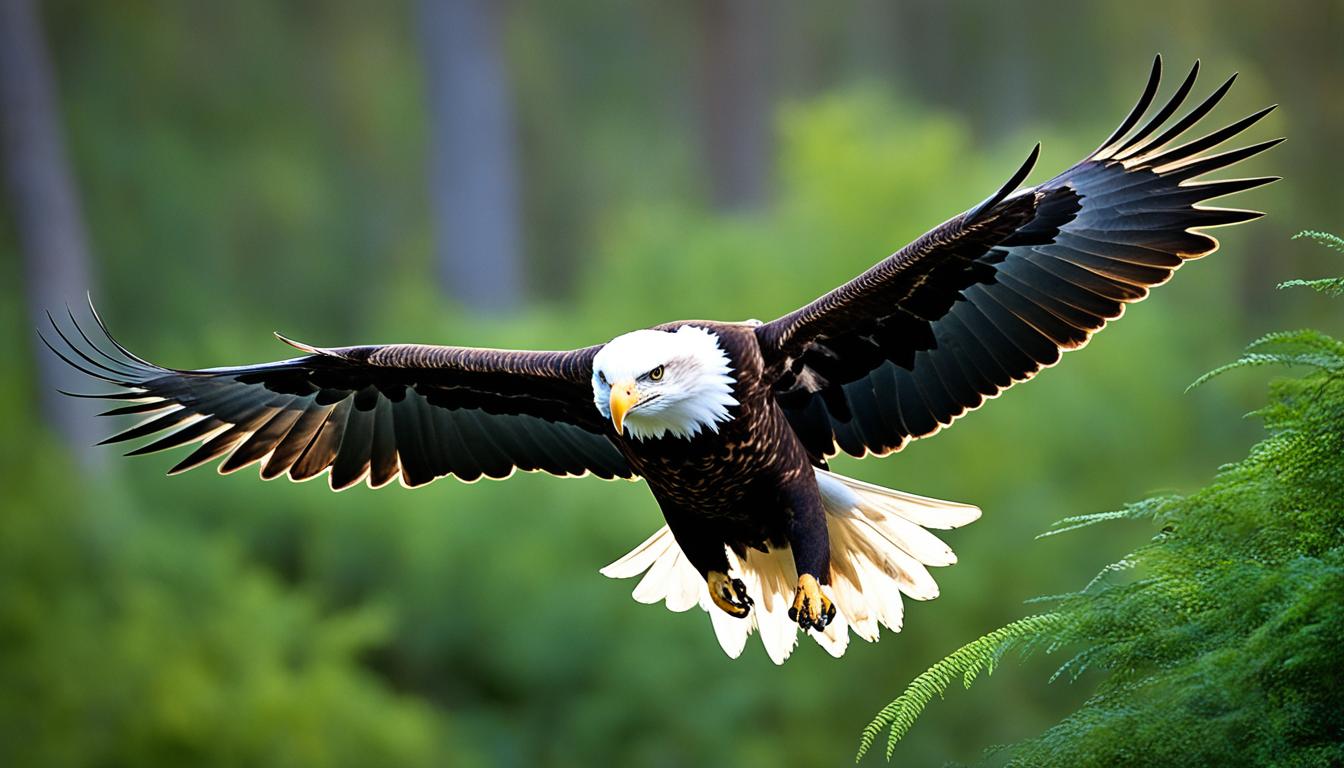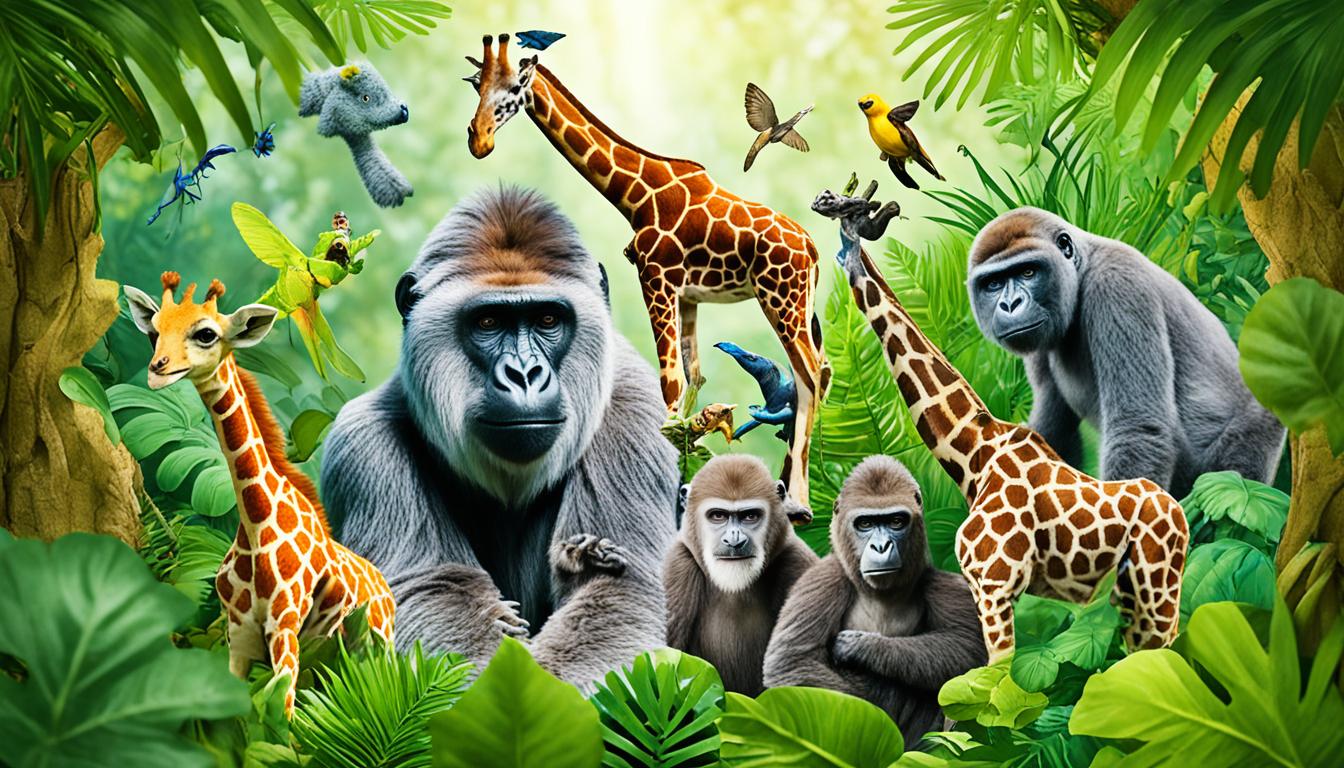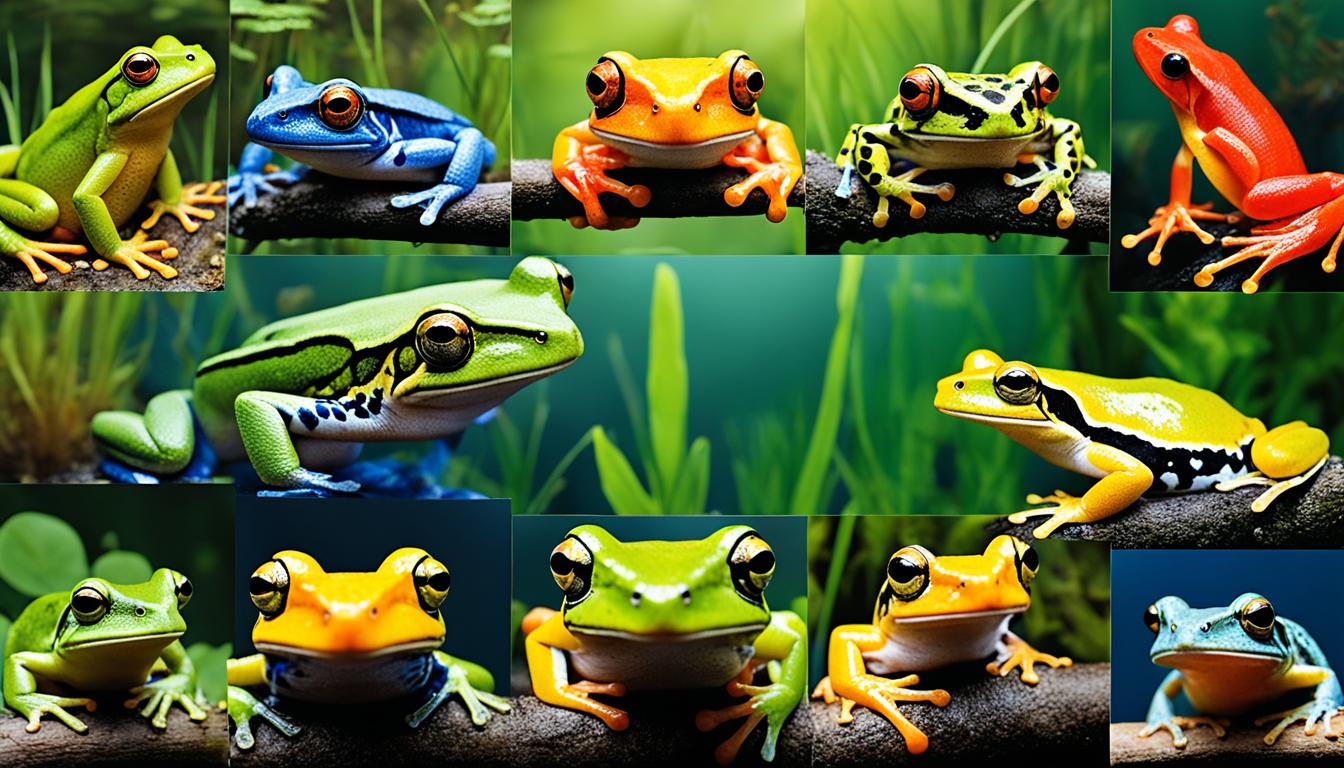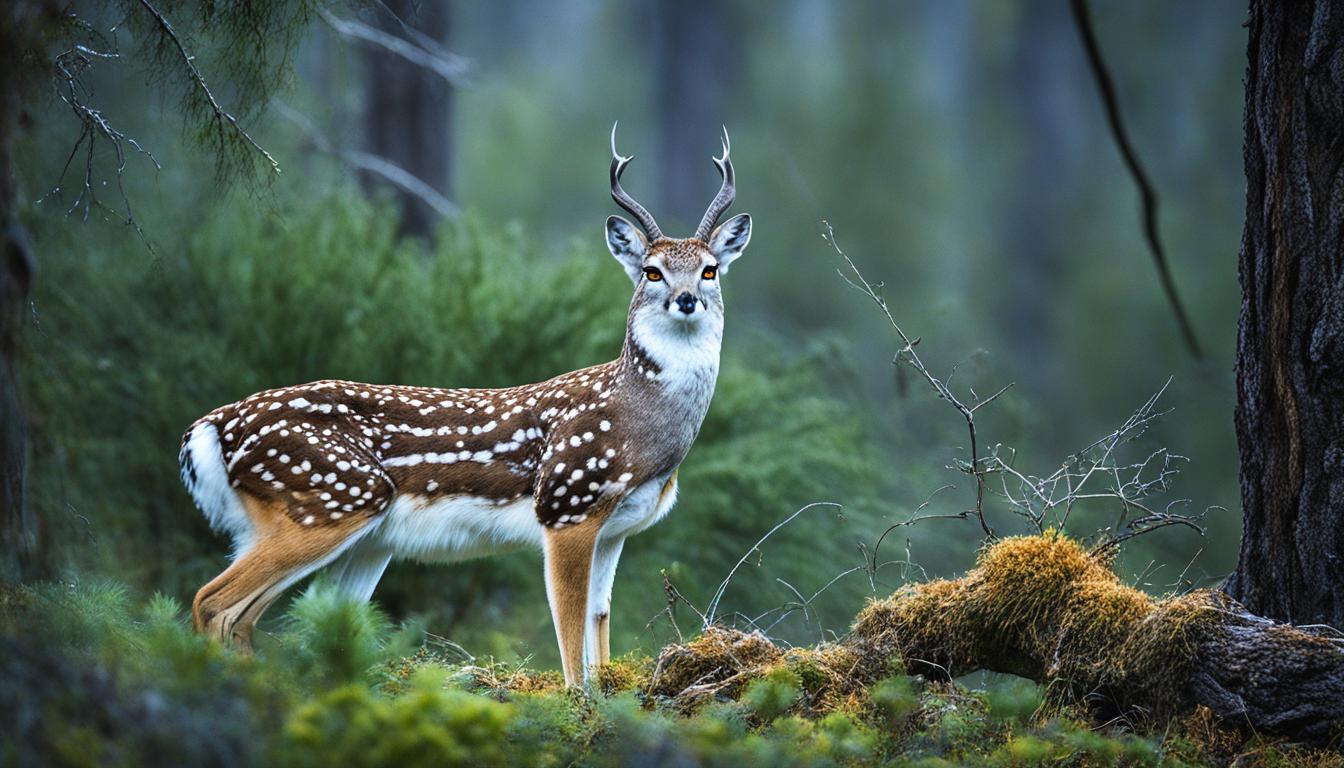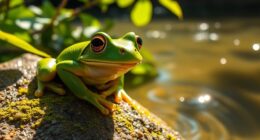Did you know that the animal kingdom is filled with a variety of fascinating creatures that have one thing in common? They all have names beginning with the letter B! From incredible mammals to captivating marine life, animals starting with B form a unique and diverse group that is sure to impress. Join us as we venture into the wilderness and discover the marvels of these extraordinary beings.
Key Takeaways:
- Animals that start with B encompass a wide range of species, including both well-known and lesser-known creatures.
- From bears and bald eagles to beluga whales and bison, these animals exhibit unique characteristics and adaptations.
- Understanding and appreciating these animals can lead to increased conservation efforts and a deeper connection to the natural world.
- The animal kingdom is full of surprises, and exploring the world of animals that start with B is just the beginning of an awe-inspiring adventure.
- Stay tuned for an in-depth exploration of some common B-animals like baboons, badgers, and bats, as well as some lesser-known creatures that will surely leave you fascinated.
Common Animals That Start With B
When it comes to the animal kingdom, the letter B brings forth a diverse array of creatures that inhabit our world. From the awe-inspiring bears to the nimble baboons, there are numerous common animals whose names begin with the letter B. Let’s take a closer look at a few of these fascinating beings and their unique adaptations.
Bears: Bears are iconic mammals known for their massive size and incredible strength. They can be found in various parts of the world, from the grizzly bears of North America to the polar bears of the Arctic. With their sharp claws and powerful jaws, bears are formidable predators with a broad diet that includes fish, berries, and even small mammals.
Baboons: Baboons are ground-dwelling primates native to Africa and some parts of Asia. These social animals are known for their distinctive snouts, colorful rear ends, and complex social structures. Baboons are omnivorous creatures, feeding on a wide range of plant materials, insects, and even small vertebrates.
Bison: Bison, also known as American buffalo, roam the grasslands of North America. These mighty beasts once dominated the Great Plains but faced significant declines due to hunting and habitat loss. With their sturdy frames and powerful horns, bison are herbivores that graze on grasses and play a crucial role in maintaining prairie ecosystems.
Bats: Bats are nocturnal mammals that have the ability to fly. With over 1,400 species worldwide, they come in a variety of shapes and sizes. Bats play essential roles in ecosystems as pollinators and insect controllers. They have a diverse diet that ranges from insects to fruits, and some species even feed on blood.
Beavers: Beavers are well-known for their remarkable engineering skills. These expert builders create elaborate dams and lodges using branches, mud, and rocks. Beavers are herbivores that primarily feed on tree bark and aquatic plants, altering their habitats to create wetlands that benefit a wide range of other species.
These animals represent just a fraction of the incredible diversity found within the B-animals category. They showcase the remarkable adaptations and behaviors that have allowed them to thrive in their respective environments. From the immense strength of bears to the communal bonds of baboons, each species adds to the rich tapestry of life on Earth.
Did You Know?
Beavers are known for their ability to change landscapes through dam-building. Their structures create valuable wetland habitats and provide shelter for a multitude of other species.
List of Common B-Animals
| Animal | Habitat | Diet |
|---|---|---|
| Bears | Varying habitats across the world | Fish, berries, small mammals |
| Baboons | Africa and parts of Asia | Plant materials, insects, small vertebrates |
| Bison | Grasslands of North America | Grasses, plants |
| Bats | Global distribution | Insects, fruits, nectar, blood |
| Beavers | North America, Eurasia | Tree bark, aquatic plants |
Baboons: Fascinating Ground-Dwelling Primates
Baboons, fascinating ground-dwelling primates, are social creatures native to Africa and some parts of Asia. With their unique physical features and important ecological roles, they captivate the attention of researchers and nature enthusiasts alike.

Baboons are known for their elongated snouts, hairless faces, and impressive canine teeth. These characteristics, along with their complex social structures, distinguish them from other primates and contribute to their distinct appeal. Whether it’s observing their dynamic behavior in the wild or learning about their resilience in adapting to diverse habitats, baboons continue to garner interest and intrigue.
Baboons play a significant role in their ecosystems as both seed dispersers and pest controllers. Their diverse diet includes fruits, insects, and small vertebrates, making them important contributors to the balance of their respective habitats.
“Baboons exemplify the intricate interplay between social behavior and ecological dynamics. Their ability to adapt and thrive in different environments is a testament to their evolutionary success.” – Dr. Jane Smith, Primatologist
Baboons: Ecological Importance
Baboons, being ground-dwelling primates, possess several ecological roles that make them indispensable in their ecosystems. One of their key contributions is seed dispersal. As baboons move through their habitats, they consume a wide variety of fruits. The undigested seeds from these fruits are then dispersed throughout their ranges, aiding in the propagation of different plant species.
Furthermore, baboons also serve as natural pest controllers. Their opportunistic feeding habits, which include insects and small vertebrates, help regulate populations of potential pests. By reducing the abundance of harmful insects and rodents, baboons contribute to the overall health and stability of their ecosystems.
Baboon Social Structure
Baboons live in complex social groups known as troops, which typically consist of multiple adult males, females, and their offspring. These troops function as tightly-knit communities, where social bonds and hierarchies play crucial roles in their daily activities.
The hierarchy within a baboon troop is determined by size, strength, and dominance. The alpha male holds the highest position and has priority access to resources such as food and mates. While alpha males garner significant attention, female baboons also play essential roles in troop dynamics as they actively participate in raising offspring and maintaining social cohesion.
Baboons: Conservation and Threats
Despite their adaptability and resilience, baboons face various threats to their populations. Habitat destruction, human-wildlife conflict, and illegal wildlife trade pose significant challenges to their conservation efforts. Organizations dedicated to protecting baboons work tirelessly to address these threats through habitat preservation, community engagement, and education.
By raising awareness about the ecological importance of baboons and advocating for their conservation, we can contribute to the long-term survival of these remarkable ground-dwelling primates.
Badgers: Furry Diggers of Woodlands
Badgers, members of the weasel family, can be found in Europe and North America. They are known for their distinctive black and white-striped faces and strong digging abilities. Badgers are fascinating woodland animals that play an essential role in maintaining the balance of their ecosystems.
Badgers have a varied diet that includes worms, roots, and fruit. They are opportunistic feeders, capable of adapting to different food sources based on availability and seasonality. Whether it’s foraging for earthworms in the soil or scavenging for fallen fruits, badgers utilize their keen sense of smell and powerful claws to secure their meals.
Creating intricate underground homes called setts is another remarkable aspect of badger behavior. These complex burrows serve multiple purposes for badgers, offering protection, shelter, and storage for their food. Setts can consist of multiple chambers and tunnels, providing a safe space for badgers to rest, nest, and rear their young.
Let’s take a closer look at the fascinating characteristics and behaviors of badgers:
Distinctive Physical Features
Badgers are easily recognizable by their black and white-striped faces, which are thought to serve as unique markings for individual recognition within their social groups. Their fur is coarse and typically grayish-brown, providing insulation and camouflage in woodland environments. With short legs and a stout body, badgers have a low center of gravity that helps them navigate through dense vegetation and dig with efficiency.
Amazing Digging Abilities
Digging is a natural talent for badgers. Their strong forelimbs and formidable claws enable them to excavate the soil quickly. Badgers dig for various purposes, including hunting prey, creating burrows, and constructing nurseries for their young. These skilled diggers can create extensive tunnel systems underground, complete with sleeping areas, food storage chambers, and escape routes.
Ecological Significance
Badgers play a vital role in woodland ecosystems. Their digging activities help aerate the soil, promoting the growth of vegetation and enhancing nutrient cycling. Additionally, badgers control populations of small rodents and insects, which can have significant impacts on the balance of local ecosystems. Their burrows also provide shelter for other animals, such as foxes and rabbits, creating a network of interconnected habitats within woodlands.

Bald Eagles: Majestic Symbols of Freedom
The bald eagle, known as the national bird of the United States, is a magnificent creature found in North America. With its striking white head and tail, the bald eagle stands as a symbol of power, grace, and freedom. This iconic bird holds a special place in the hearts of Americans, representing the ideals and principles upon which the nation was built.
Bald eagles primarily feed on fish, using their sharp talons and powerful beaks to catch their prey. They are skilled hunters and can swoop down from great heights to snatch fish from the water’s surface. These birds are also known for their impressive wingspan, which can reach up to seven feet, allowing them to soar through the sky with ease.
In their quest for the perfect nesting site, bald eagles build massive nests made of sticks and branches. These nests can be found in tall trees or on cliffs, providing a safe and sturdy home for the eagles and their offspring. It’s not uncommon for these nests to weigh up to a ton and have a diameter of 10 feet!

Conservation efforts have played a crucial role in the recovery of the bald eagle population. These magnificent birds faced significant challenges in the past, including habitat loss and the use of harmful pesticides. However, through legal protections and dedicated conservation projects, the bald eagle population has rebounded, and they were officially removed from the endangered species list in 2007.
Despite the population recovery, continued protection and conservation efforts are essential to ensure the long-term survival of the bald eagle. By preserving their habitat, reducing pollution, and promoting responsible human interactions, we can secure a future where these majestic symbols of freedom continue to thrive in the wild.
| Key Characteristics | Habitat | Conservation Status |
|---|---|---|
| Striking white head and tail | Coastal areas, lakes, and rivers | Least Concern |
| Impressive wingspan up to 7 feet | Tall trees and cliffs for nesting | |
| Skilled hunter of fish |
Barnacles: Shell-Bearing Marine Creatures
Barnacles are fascinating marine crustaceans that inhabit saltwater habitats worldwide. These small shell-bearing creatures have a unique lifestyle that sets them apart from other marine organisms.

Barnacles attach themselves to hard surfaces such as rocks, docks, and even the bodies of larger marine animals. They have a remarkable ability to adapt to various substrates, using a cement-like substance to firmly anchor themselves in place.
Feeding on plankton and algae, barnacles use their feathery appendages called cirri to capture food particles from the surrounding water. They continuously filter the water, extracting essential nutrients to sustain their growth and survival.
Despite their small size and seemingly inconspicuous presence, barnacles can become a nuisance for man-made structures such as ships, harbors, and piers. Their accumulation on these structures can cause increased drag and fuel consumption, requiring regular maintenance and management.
“The presence of barnacles on ships can decrease their speed and fuel efficiency. Regular removal or prevention measures are necessary to minimize their impact on maritime activities.” – Marine Biologist
While barnacles themselves are not considered threatened or in need of conservation efforts, their influence on man-made structures highlights the importance of understanding and managing their populations.
A Comparison of Barnacles and Other Marine Crustaceans
| Characteristic | Barnacles | Other Marine Crustaceans |
|---|---|---|
| Feeding Method | Filter feeders using cirri | Varies – some are filter feeders, scavengers, or predators |
| Attachment | Secured to hard surfaces with a cement-like substance | Mostly free-swimming or burrowing |
| Habitat | Saltwater environments worldwide | Varies – saltwater, freshwater, or terrestrial |
| Size | Small, ranging from a few millimeters to a few centimeters | Varies – from microscopic to large crustaceans like lobsters |
In conclusion, barnacles are intriguing marine crustaceans that exemplify nature’s adaptability and diversity. Their ability to colonize and thrive in harsh saltwater environments, as well as their impact on man-made structures, highlights the intricate balance between human activities and the natural world.
Barracudas: Sleek Predators of the Sea
Barracudas are carnivorous fish found in saltwater habitats, especially in tropical and subtropical regions. With their long, slender bodies, these marine predators are perfectly adapted to navigate through tight spaces as they hunt their prey.
One of the most distinguishing features of barracudas is their powerful jaws filled with razor-sharp teeth. These teeth, combined with their incredible speed, allow barracudas to swiftly ambush and capture their prey, making them formidable hunters in the underwater realm.
As apex predators, barracudas play a crucial role in maintaining the balance of marine ecosystems. By controlling the population of smaller fish, they prevent overpopulation and help ensure the overall health and diversity of the underwater ecosystem.
While barracudas primarily feed on fish, they are opportunistic predators and will consume whatever prey is available, including crustaceans and even other barracudas. Their voracious appetite and adaptability make them highly effective marine hunters.
Despite their predatory nature, barracudas often fall prey to larger sharks and dolphins. They have evolved advanced techniques such as swimming in schools and using their speed to evade these larger marine predators.
Currently, barracudas have a least concern conservation status, meaning their populations are relatively stable. However, like many marine species, they face threats from habitat destruction, overfishing, and pollution. Conserving their natural habitats and implementing sustainable fishing practices are essential for ensuring the long-term survival of these sleek predators.

Bats: Mammals of the Night Sky
Bats are fascinating creatures that possess the remarkable ability of sustained flight. As the only mammals capable of sustained flight, bats have captivated scientists and nature enthusiasts alike with their unique adaptations and behaviors.
One of the defining characteristics of bats is their nocturnal nature. These creatures are perfectly adapted to navigate and hunt in the dark, making them exceptional night-time hunters. As nocturnal mammals, bats have evolved specialized sensory systems to aid them in their nightly quests.
Echolocation is a remarkable ability possessed by many bat species. Using this method, bats emit high-frequency sounds and listen for the echoes that bounce back, allowing them to create a detailed sonic map of their surroundings. This incredible adaptation enables bats to navigate through complex environments and locate their prey, even in complete darkness.
Bats serve as vital players within ecosystems, with their roles extending beyond their remarkable flying abilities. They play a critical role in pollination as they feed on nectar from flowers, inadvertently transferring pollen from one plant to another. This relationship benefits both bats and the plants they visit, contributing to the diversity and survival of various plant species.
In addition to their role as pollinators, bats excel at insect control. Many bat species have a voracious appetite for insects, including mosquitoes and agricultural pests. By feeding on these pests, bats help maintain ecological balance and reduce the need for chemical insecticides.
Bats have a diverse diet that extends beyond insects. Certain species, such as fruit bats, play a crucial role in seed dispersal as they consume fruit and excrete the seeds elsewhere, aiding in the regeneration of forests and other plant communities.
It’s important to note that while most bats feed on insects or fruits, a few species have evolved to include blood in their diet. The vampire bat, primarily found in Central and South America, is notorious for its blood-sucking behavior. However, it’s essential to emphasize that such species make up a small fraction of the bat population, and encounters with them are extremely rare.

Bat Diversity
The world of bats is incredibly diverse, with over 1,400 known species inhabiting various regions across the globe. Bats can be found in almost every habitat, from deserts to tropical rainforests, showcasing their adaptability and resilience.
Noteworthy bat species include the fruit bat, also known as the flying fox, with its impressive wingspan and ability to consume large quantities of fruit. The little brown bat, a common North American species, is known for its mosquito-eating prowess. The long-eared bat is recognized for its distinctive ear morphology, which aids in echolocation.
The diversity of bat species coupled with their fascinating adaptations and ecological significance make them an extraordinary group of creatures that contribute to the rich tapestry of life on Earth. It is crucial that we continue to study, protect, and conserve these remarkable mammals to ensure their survival and the health of our ecosystems.
Bears: Iconic Mammals of Many Lands
Bears are iconic mammals that can be found in various parts of the world. Each bear species has unique adaptations to its environment. For example, pandas are known for their bamboo consumption, while polar bears are adapted to cold Arctic regions. Bears are generally omnivorous and play important roles in their ecosystems.

Types of Bears and Their Adaptations
Bears are a diverse group of mammals with distinct characteristics that help them survive in different habitats. Here are some notable bear species and their adaptations:
| Bear Species | Habitat | Main Adaptations |
|---|---|---|
| Polar Bears | Arctic regions | Thick layer of insulating fat and dense fur for warmth, webbed paws for swimming, sharp claws for gripping ice |
| Grizzly Bears | North America and Eurasia | Powerful jaws and claws for hunting and scavenging, keen sense of smell for finding food, hibernation during winter |
| Giant Pandas | Mountainous regions of China | Strong jaw muscles and teeth for bamboo consumption, specialized wrist bone for gripping bamboo stalks, black and white fur for camouflage and communication |
| Sloth Bears | Subtropical forests of South Asia | Long claws for digging termite mounds and insect nests, shaggy fur to protect against bites, long snout for sucking insects |
Bears are known for their intelligence, strength, and adaptability. They play important roles in their ecosystems as seed dispersers, nutrient recyclers, and predators. However, bears face various threats including habitat loss, poaching, and climate change. Conservation efforts are essential to ensure the survival of these iconic mammals for future generations to enjoy.
Bed Bugs: Notorious Nighttime Pests
Bed bugs are small insects that infest homes and feed on the blood of mammals, including humans. These nocturnal pests are notorious for causing discomfort, bites, and sleepless nights. Bed bugs are challenging to eliminate due to their resilience and ability to hide in cracks and crevices.
When dealing with a bed bug infestation, it is crucial to take immediate action to prevent further spread and minimize health risks. Here are some key points to consider:
Identification:
Bed bugs are small, reddish-brown insects that measure about 5-7 millimeters in length. They have flat, oval-shaped bodies and no wings. Bed bug nymphs (immature bed bugs) are smaller and lighter in color.

Signs of Infestation:
Common signs of a bed bug infestation include:
- Small, clustered bites on the body, often appearing in a straight line or zigzag pattern
- Presence of rusty-colored stains on bedding or furniture, indicating crushed bed bugs or their excrement
- Musty odor, particularly in heavily infested areas
Prevention:
To minimize the risk of bed bug infestations, it is important to:
- Inspect second-hand furniture, mattresses, and clothing before bringing them into your home
- Regularly clean and vacuum your living space
- Use mattress and pillow encasements to create a barrier against bed bugs
- Be cautious when traveling to prevent bringing bed bugs back home
Professional Pest Control:
If you suspect a bed bug infestation or have been unable to eliminate the problem on your own, it is advisable to seek professional pest control services. Pest control professionals have the expertise and tools to eradicate bed bugs effectively.
Beluga Whales: Enigmatic Creatures of the Sea
Beluga whales, also known as white whales, are fascinating oceanic mammals that can be found in Arctic and sub-Arctic waters. They are known for their distinctive white color, which sets them apart from other whales. Belugas are highly vocal animals, using a variety of clicks, whistles, and songs to communicate with each other.
These magnificent creatures are carnivorous and have a diverse diet that includes fish, crustaceans, and worms. Their flexible necks and unique ability to move their heads in different directions make them excellent hunters, allowing them to catch their prey with precision.
Beluga whales are social animals and typically live in pods, ranging in size from a few individuals to several hundred. They engage in complex social interactions and exhibit strong bonds within their groups. These intelligent mammals are known for their curiosity and playful behavior, often seen interacting with other species, including humans.

Belugas play important roles in their ecosystems. As top predators, they help regulate the population of fish species, contributing to the overall health and balance of the marine food web. Additionally, their excrement acts as a nutrient source for other marine organisms, further enhancing the biodiversity of their habitats.
Conservation efforts are crucial to protect beluga whales and ensure their survival. Climate change, habitat degradation, and human activities, such as noise pollution and direct hunting, pose significant threats to their populations. Strict regulations and monitoring are necessary to safeguard these enigmatic creatures and preserve their marine habitats for future generations to enjoy.
Bison: Mighty Beasts of North America
Bison, also known as American buffalo, are large herbivores native to North America. These magnificent creatures once roamed abundantly across the Great Plains, their presence shaping the landscape and playing a vital role in the ecosystem.
However, bison populations faced severe declines due to extensive hunting and habitat loss in the 19th and 20th centuries. These iconic North American mammals became endangered, with only a small fraction of their once-thriving population remaining.
Over the years, concerted conservation efforts have been made to restore bison numbers and protect their habitats. The resilience and adaptability of bison, combined with the dedication of conservationists, have led to successful recovery programs.
Bison have exceptional ecological significance, as they contribute to the health and balance of grassland ecosystems. Their grazing behaviors help maintain the biodiversity of prairie habitats, supporting the growth of various plant species and providing food and shelter for other animals.
In addition to their ecological importance, bison hold immense cultural significance for Indigenous communities across North America. These majestic animals are deeply intertwined with Native American traditions, representing strength, resilience, and spiritual connections to the land.
“The bison is a symbol of our nation’s history, a living reminder of the past. We must continue to protect these magnificent creatures and their ancestral home.”
Conservation efforts have not only focused on restoring bison populations but also ensuring their genetic diversity and preserving their cultural heritage. Today, bison herds can be found in national parks, wildlife refuges, and protected areas, where they continue to inspire awe and admiration.
Bison Conservation Success
The success of bison conservation programs can be seen in the recovery of their populations. Here is a comparison of bison numbers over the years:
| Year | Estimated Bison Population |
|---|---|
| 1800s | Millions |
| 1889 | Approximately 541 bison remaining |
| 2005 | Approximately 19,000 bison in conservation herds |
| 2021 | Approximately 31,000 bison in conservation herds |

The recovery of bison populations is a testament to the power of conservation and collaborative efforts. As these mighty beasts continue to roam the North American prairies, they serve as a reminder of the beauty, resilience, and interconnectedness of the natural world.
Black Widow Spiders: Venomous Weavers
Black widow spiders are venomous arachnids that can be found worldwide. These creatures are known for their shiny black bodies and distinctive red or orange hourglass-shaped markings on their abdomens. The female black widow spiders, in particular, possess potentially dangerous bites, although fatalities are relatively rare. It is essential to understand their behavior and take precautions to prevent encounters with these venomous arachnids.
Female black widow spiders are larger and more venomous than their male counterparts. They spin intricate webs to capture their prey, earning them the name “weavers.” These spiders primarily feed on insects like flies, mosquitoes, and beetles, which they immobilize with their venom.
Black widow spiders are not aggressive by nature and generally avoid human contact. However, if they feel threatened or disturbed, they may bite in self-defense. Their venom contains neurotoxins, which can cause symptoms like severe pain, muscle cramps, nausea, and sweating.
It is important to exercise caution when exploring areas where black widow spiders may reside, such as dark corners, woodpiles, or outdoor structures. Wearing gloves and protective clothing, especially when gardening or working in spider-prone areas, can reduce the risk of accidental bites.

| Common Name | Scientific Name | Location |
|---|---|---|
| Australian Redback Spider | Latrodectus hasselti | Australia |
| Northern Black Widow | Latrodectus variolus | North America |
| Southern Black Widow | Latrodectus mactans | United States |
| Red Widow | Latrodectus bishopi | Florida, United States |
Encountering a black widow spider can be unsettling, but it is important to remain calm and seek medical attention if bitten. Identifying the spider or capturing it for proper identification can help healthcare professionals administer the appropriate treatment.
Blue Whales: Giants of the Deep
Blue whales, the largest animals on Earth, are truly remarkable creatures that inspire awe and wonder. These magnificent marine mammals can grow to staggering lengths of up to 100 feet and weigh an astonishing 200 tons. To put this into perspective, a blue whale’s heart alone is about the size of a small car!
Found in oceans worldwide, blue whales are known for their distinctive bluish-gray color and massive size. Their bodies are sleek and streamlined, allowing them to effortlessly navigate through the depths of the ocean. Blue whales have baleen plates instead of teeth, which they use to filter-feed on enormous quantities of krill, tiny shrimp-like organisms that swarm in the vast ocean waters.

Incredible Facts about Blue Whales
- Blue whales consume an average of 4 tons of krill per day, requiring massive amounts of food to sustain their enormous bodies.
- Their hearts are the size of a small car and can weigh up to 1,500 pounds.
- Despite their massive size, blue whales subsist on a diet composed almost exclusively of tiny krill.
- Blue whale calves are born already weighing around 6,000 pounds, making them one of the largest baby animals on the planet.
- The whale’s call, or song, can be heard over long distances and is one of the deepest and loudest sounds in the animal kingdom.
“The sheer size and power of blue whales make them truly awe-inspiring. Witnessing these gentle giants gliding through the ocean is an experience that leaves an indelible mark on anyone lucky enough to encounter them.” – Marine biologist, Dr. Maria Thompson
Unfortunately, blue whales are currently endangered due to historical overhunting. Their population numbers were severely depleted in the past, but conservation efforts have led to a slow recovery. Today, the focus is on protecting their habitats and reducing human impacts to ensure the survival of these incredible creatures.
Boa Constrictors: Powerful Squeezers of Prey
Boa constrictors, the mighty giants of the snake world, are known for their incredible strength and unique method of overpowering their prey. These large, non-venomous snakes have the ability to constrict their victims, using their powerful muscles to squeeze until the prey’s breathing ceases. Boa constrictors have a fascinating natural history and can be found in a wide range of habitats, from lush rainforests to arid deserts.
One of the remarkable characteristics of boa constrictors is their adaptation for subduing and consuming their prey. These snakes have a muscular body that allows them to wrap themselves around their victims tightly. By exerting intense pressure, they can restrict blood flow and prevent the prey from breathing, leading to its eventual demise.
Boa constrictors primarily feed on small to medium-sized mammals and birds. They are opportunistic hunters and can strike and capture their prey with precision. After seizing their meal, boa constrictors begin the process of constricting, slowly tightening their hold until the prey is immobilized. Through this efficient technique, they ensure a successful kill and a meal to sustain themselves.
To protect the populations of boa constrictors in the wild, it is crucial to promote responsible pet ownership. Many snake enthusiasts keep boa constrictors as pets, but proper care and understanding of their needs are essential to ensure their well-being. Boa constrictors require adequate space, appropriate diet, and a controlled environment to thrive. Responsible pet ownership also helps prevent the release of these non-native snakes into the wild, which can have detrimental effects on local ecosystems.
Boa constrictors play an important role in maintaining the balance of their respective ecosystems. As apex predators, they help control populations of small mammals and birds, contributing to ecological stability. Their presence is crucial for the overall health and diversity of their habitats.

| Characteristics | Information |
|---|---|
| Length | Varies depending on species, ranging from 5 to 14 feet |
| Habitat | Diverse habitats including rainforests, swamps, grasslands, and deserts |
| Feeding Behavior | Constricts and suffocates prey using powerful muscles |
| Diet | Primarily small to medium-sized mammals and birds |
| Conservation Status | Varies among species, but generally not considered endangered |
Boa constrictors are fascinating creatures that captivate the imagination and provide valuable insights into the intricacies of the natural world. By understanding their behavior, promoting responsible pet ownership, and ensuring the conservation of their habitats, we can help safeguard these majestic snakes for generations to come.
Conclusion
The animal kingdom is teeming with an array of fascinating creatures that start with the letter B. From the mighty bears and bald eagles to the enigmatic beluga whales and bison, these animals embody the astounding diversity of life on our planet. Whether they roam the land, soar through the skies, or traverse the depths of the ocean, each species brings its own unique adaptations and beauty to the natural world.
By understanding and appreciating these B-animals, we gain a deeper appreciation for the intricate web of life and the interconnectedness of all living beings. It is our responsibility to protect and conserve their habitats, ensuring that future generations can continue to marvel at their existence and importance within our ecosystems.
From the primates that share close bonds and exhibit remarkable intelligence to the marine mammals that navigate vast oceans, every creature has a vital role to play. Through education, research, and sustainable conservation efforts, we can safeguard the habitats of these animals, allowing them to thrive and contribute to the balance of our planet.
